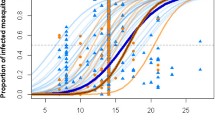Abstract
Biological invasion is an important area of research in mathematical biology and more so if it concerns species which are vectors for diseases threatening the public health of large populations. That is certainly the case for Aedes aegypti and the dengue epidemics in South America. Without the prospect of an effective and cheap vaccine in the near future, any feasible public policy for controlling the dengue epidemics in tropical climates must necessarily include appropriate strategies for minimizing the mosquito population factor. The present paper discusses some mathematical models designed to describe A. aegypti’s vital and dispersal dynamics, aiming to highlight practical procedures for the minimization of its impact as a dengue vector. A continuous model including diffusion and advection shows the existence of a stable travelling wave in many situations and a numerical study relates the wavefront speed to a few crucial parameters. Strategies for invasion containment and its prediction based on measurable parameters are analysed.
Similar content being viewed by others
References
Carr, J., 1981. Applications of Center Manifold Theory. Springer, New York.
Cummings, D.A.T., Irizarry, R.A., Huang, N.E., Endy, T.P., Nisalak, A., Ungchusak, K., Burke, D.S., 2004. Travelling waves in the occurrence of dengue haemorrhagic fever in Thailand. Nature 427, 344–347.
Ereno, D., 2003. Novas armas contra a dengue. Revista Pesquisa Fapesp 85. http://revistapesquisafapesp.br.
Ermentrout, B., 2002. Simulating, Analyzing, and Animating Dynamical Systems. A Guide to XPPAUT for Researchers and Students. SIAM.
Ferreira, C.P., Yang, H.M., 2003. Estudo dinâmico da população de mosquitos Aedes aegypti, TEMA—Seleta do XXV CNMAC 4.2, SBMAC e FAPESP, São Carlos e São Paulo, pp. 187–196.
Gubler, D.J., 1998. Dengue and dengue hemorrhagic fever. Clin. Microb. Rev. 11, 480–496.
Hagstrom, T, Keller, H.B., 1986. The numerical calculation of travelling wave solutions of nonlinear parabolic equations. SIAM J. Sci. Stat. Comput. 7, 978–985.
Hartman, P., 1973. Ordinary Differential Equations. Hartman, Baltimore.
Heinze, S., Papanicolaou, G., Stevens, A., 2001. Variational principles for propagation speeds in inhomogeneous media. SIAM J. Appl. Math. 621, 129–148.
Lucia, M., Muratov, C.B., Novaga, M., 2004. Linear vs. nonlinear selection for the propagation speed of the solutions of scalar reaction-diffusion equations invading an unstable equilibrium. Comm. Pure Appl. Math. 57, 616–636.
Murray, J.D., 1993. Mathematical Biology. Springer, Berlin.
Murray, J.D., Stanley, E.A., Brown, D.L., 1986. On the spatial spread of rabies among foxes. Proc. R. Soc. Lond. B 229, 111–150.
Pauwelussen, J.P., 1981. Nerve impulse propagation in a branching nerve system: a simple model. Physica 4D, 67–88.
Potapov, A.B., Lewis, M.A., 2004. Climate and competition: the effect of moving range boundaries on habitat invasibility. Bull. Math. Biol. 66, 975–1008.
Sandstede, B., 2002. Stability of travelling waves. In: Fiedler, B. (Ed.), Handbook of Dynamical Systems II. Elsevier, Amsterdam, pp. 983–1059.
Segel, L.A. (Ed.), 1980. Mathematical Models in Molecular and Cellular Biology. Cambridge University Press, Cambridge.
Shigesada, N., Kawasaki, K., 1997. Biological Invasions: Theory and Practice. Oxford University Press.
Takahashi, L.T., 2004. Modelos Matemáticos de Epidemiologia com Vetores: Simulação da Propagação Urbana e Geográfica da Dengue. Ph.D. Thesis, Univ. Estadual de Campinas—UNICAMP, Campinas, Brazil.
Teixeira, C.F., da S. Augusto, L.G., Morata, T.C., 2003. Hearing health of workers exposed to noise and insecticides. Rev. Saúde Pública 37, 417–423.
Vasconcelos, P.F.C., Rosa, A.P.A.T., Pinheiro, F.P., Rodrigues, S.G., Rosa, E.S.T., Cruz, A.C.R., Rosa, J.F.S.T., 1999. Aedes aegypti, dengue and re-urbanization of yellow fever in Brazil and other South American Countries—past and present situation and future perspectives. Dengue Bulletin 23, 1–10. http://www.cepis.ops-oms.org/bvsair/e/repindex/repi78/pagina/text/fulltext/vol23.pdf.
Veronesi, R., 1991. Doenças Infecciosas e Parasitárias. Guanabara Koogan, Rio de Janeiro.
Volpert, A.I., Volpert, V.A., 1994. Travelling Wave Solutions of Parabolic Systems. American Mathematical Society, Providence, RI.
Weinberger, F.H., 1982. Long-time behavior of a class of biological models. SIAM J. Math. Anal. 13, 353–396.
Yang, H.M., Ferreira, C.P., Ternes, S., 2003. Dinâmica populacional do vetor transmissor da dengue, TEMA-Seleta do XXV CNMAC 4.2, SBMAC e FAPESP, São Carlos e São Paulo, pp. 287–296.
Author information
Authors and Affiliations
Corresponding author
Rights and permissions
About this article
Cite this article
Takahashi, L.T., Maidana, N.A., Ferreira, W.C. et al. Mathematical models for the Aedes aegypti dispersal dynamics: Travelling waves by wing and wind. Bull. Math. Biol. 67, 509–528 (2005). https://doi.org/10.1016/j.bulm.2004.08.005
Received:
Accepted:
Issue Date:
DOI: https://doi.org/10.1016/j.bulm.2004.08.005




